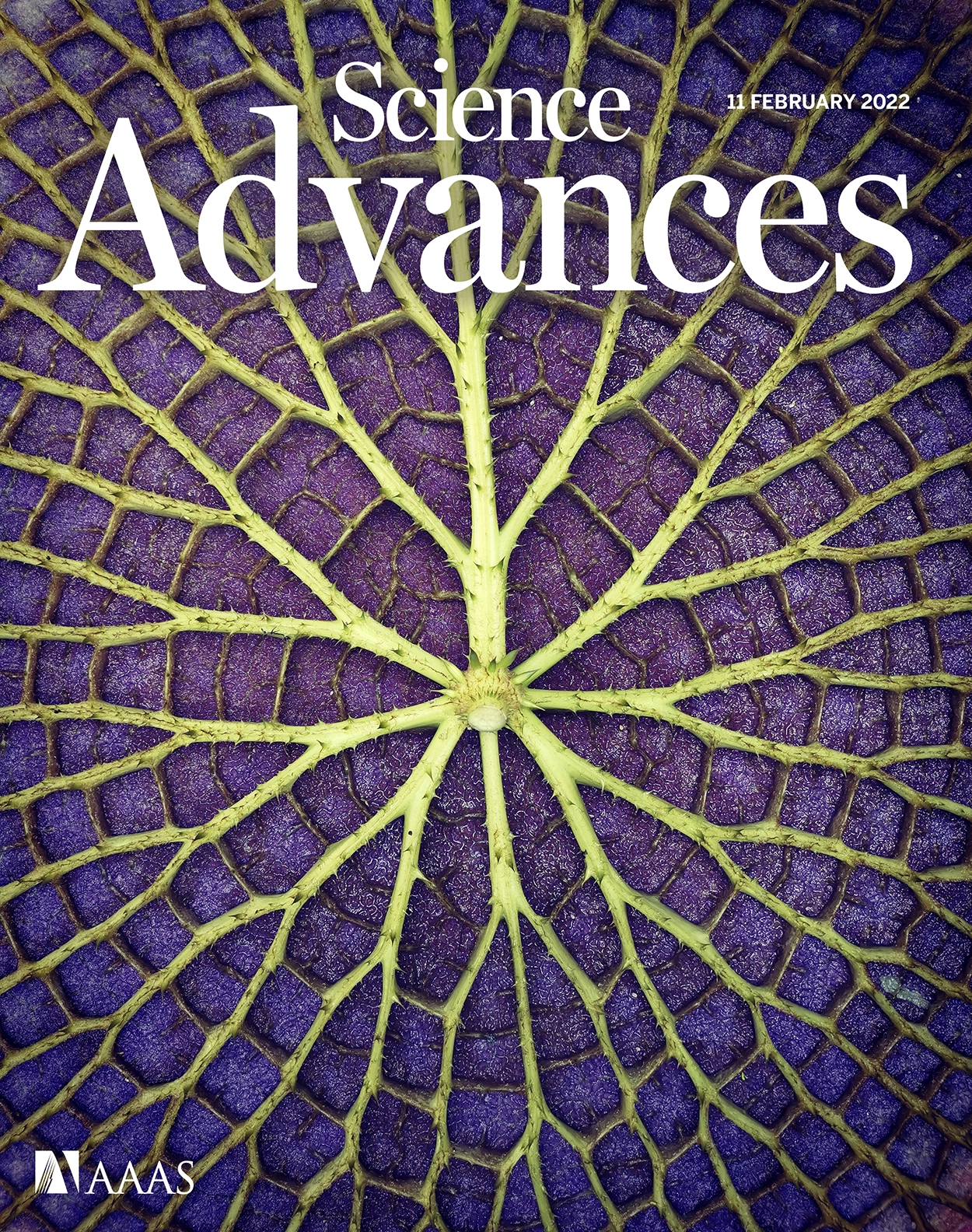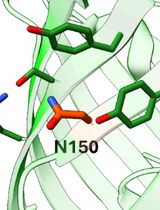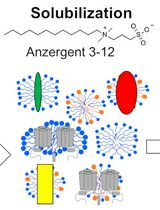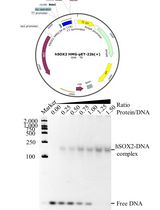- EN - English
- CN - 中文
Expression and Purification of scFv2H7-P18F3, a Bi-Modular Fusion Protein (BMFP) Targeting Human CD20
靶向人CD20的双模块融合蛋白scFv2H7-P18F3的表达和纯化
发布: 2023年05月20日第13卷第10期 DOI: 10.21769/BioProtoc.4682 浏览次数: 1644
评审: Victor TseRan ChenKuo-Ching MeiSuresh Kumar
Abstract
P18F3-based bi-modular fusion proteins (BMFPs), designed to re-direct pre-existing anti-Epstein-Barr virus (EBV) endogenous polyclonal antibodies towards defined target cells, demonstrated efficient biological activity in a mouse tumor model and could potentially represent a universal and versatile platform to develop novel therapeutics against a broad range of diseases. This protocol provides step-by-step instructions for expressing scFv2H7-P18F3, a BMFP targeting human CD20, in Escherichia coli (SHuffle®), and for purifying soluble proteins using a two-step process, namely immobilized metal affinity chromatography (IMAC) followed by size exclusion chromatography. This protocol can also be used for expression and purification of other BMFPs with alternative binding specificities.
Keywords: BMFP (BMFP)Background
During the last decades, monoclonal antibody therapy has proven to be very effective for the treatment of many diseases such as cancers (Zahavi and Weiner, 2020), chronic inflammatory diseases (Voge and Alvarez, 2019), and certain diseases of infectious origin such as COVID-19 (Hwang et al., 2022). Nevertheless, the complex nature of immunoglobulins (Ig) (molecules of high molecular weight, with multiple chains and post-translational modifications impacting their effector functions) requires the use of demanding heterologous expression systems (mostly eukaryotic cell-based systems) for industrial production, which results in high manufacturing costs. To overcome this limitation, we recently conceptualized a novel immunotherapeutic approach and generated bi-modular fusion proteins (BMFPs), able to re-direct pre-existing anti-Epstein-Barr virus (EBV) endogenous polyclonal antibodies towards defined target cells, leading to their clearance. As a proof-of-concept, we have established that this strategy is efficient against cancer cells (Gamain et al., 2022). We have engineered and expressed, in Escherichia coli, a BMFP comprising a Fc-deficient binding moiety (scFv originating from the mouse IgG2b monoclonal antibody 2H7) targeting the human CD20 (huCD20) B-cell marker fused to a fragment of the EBV-P18 antigen (P18F3), which recruits circulating endogenous anti-P18F3 IgG in EBV+ individuals. We have shown that in vitro treatment of huCD20+ Burkitt’s lymphoma cells, in presence of plasma containing anti-P18F3 antibodies, elicits a significant activation of the antibody-dependent complement cascade and trigger FcγRIII-mediated activation of cellular pathways, leading to antibody-dependent cell-mediated cytotoxicity (Gamain et al., 2022). Furthermore, we have also demonstrated in a mouse tumor model that therapy performed with scFv2H7-P18F3 significantly leads to increased mice survival and full cancer remission in some animals (Gamain et al., 2022).
As P18F3-based BMFPs display efficient biological activity, they could potentially represent a universal and versatile platform to develop novel therapeutics against a broad range of diseases. This protocol provides step-by-step instructions for expressing and purifying scFv2H7-P18F3 in Escherichia coli (SHuffle®). It can also be used for expression and purification of other BMFPs with alternative binding specificities (Figure 1).
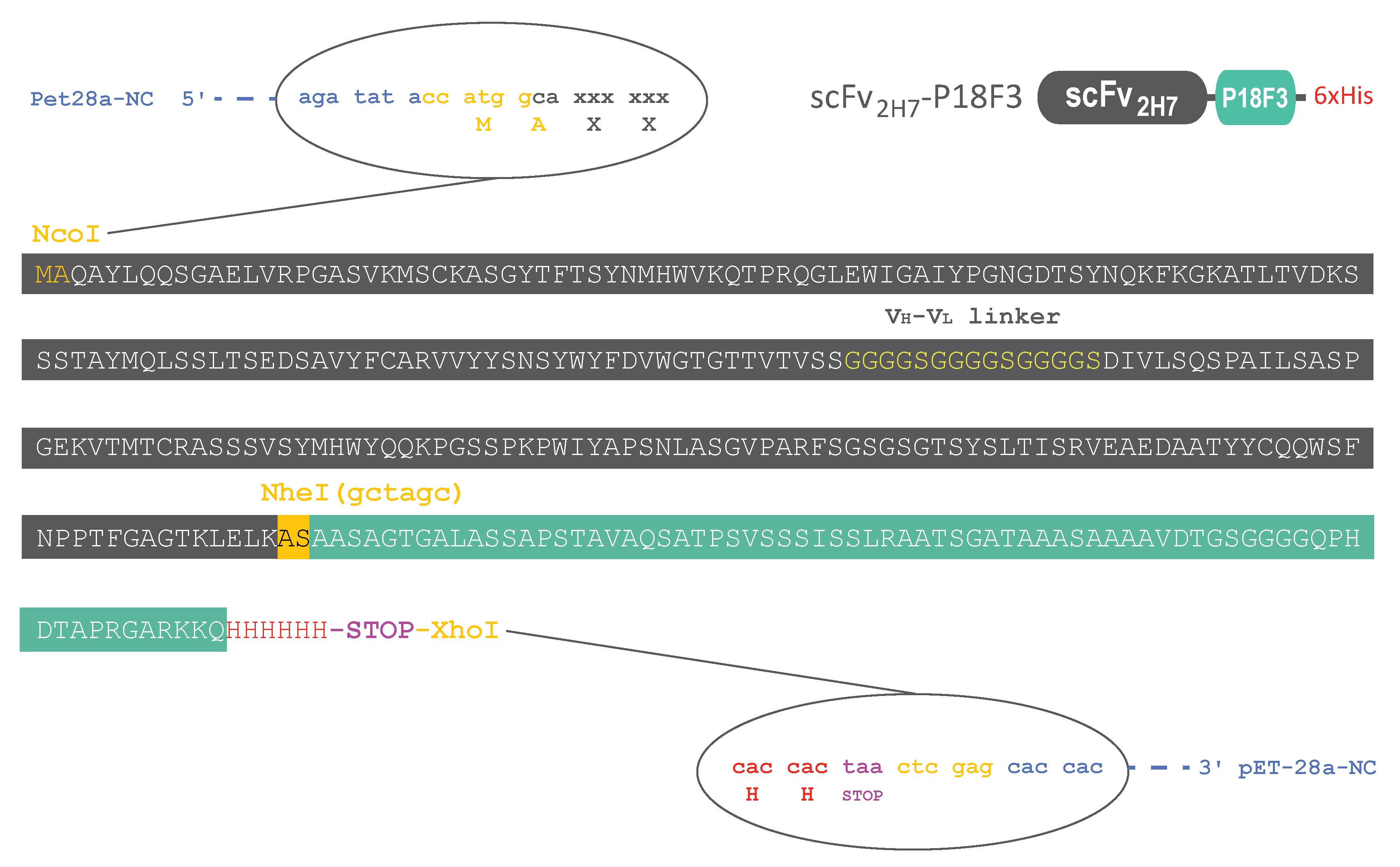
Figure 1. Standardized construct backbone for rapid and easy modulation of the binding moiety. The DNA sequence of scFv2H7-P18F3 was cloned into the pET-28a expression plasmid. The resulting amino acid sequence of scFv2H7 is displayed in dark gray, and the amino acid sequence of P18F3 is displayed in green. The recombinant protein possesses a C-terminal Histidine tag for easy purification and detection in functional assays. An alanine followed by a serine (AS) link scFv2H7 to the P18F3 polypeptide. When alternative binding specificity is desired, a new DNA sequence encoding for another binding moiety (devoid of Fc part) can be inserted between the NcoI and NheI restriction sites. We recommend using DNA sequences recoded for optimal E. coli codon usage, as it might ease the expression of the recombinant protein in SHuffle®.
Materials and Reagents
We describe here the exact materials and reagents that we use. Any equivalent materials and reagents may also be suitable for the procedure.
Materials
Filter tips PIPETMAN® DIAMOND 0.1–10 μL, 2–30 μL, 20–200 μL, 200–1,000 μL (Gilson, catalog numbers: F171203, F171303, F171503, F171703)
Sterile serology pipette; 2, 5, 10, 25, and 50 mL (Greiner, catalog numbers: 710160, 606180, 607107, 760180, 768160)
Expanded polystyrene ice bucket
Laboratory bottles with screw cap; 100 and 500 mL and 1 and 2 L (VWR, catalog numbers: 215-1592, 215-1594, 215-1595, 215-1596)
Petri dishes, polystyrene, 100 × 15 mm (Corning-Falcon, catalog number: 351029)
1.5 mL safe-lock Eppendorf microtubes (Eppendorf, catalog number: 0030121872)
Greiner culture tubes, 14 mL round bottom with snap vent cap (Merck, catalog number: Z617954)
Tube racks that can accommodate 1.5 (ø 11 mm), 15 (ø 17 mm), and 50 mL tubes (ø 30 mm)
L-shaped cell spreaders (Thermo Fisher Scientific, catalog number: SPCS01)
Tube with conical bottom; 15 and 50 mL (Corning-Falcon, catalog numbers: 352096, 352070)
Minisart high-flow syringe filter 0.2 μm pore size (Sartorius, catalog number: 16532)
Sterile syringes for single use; 1, 5, 10, and 60 mL (FisherbrandTM, Thermo Fisher Scientific, catalog numbers: 17161936, 15809152, 15819152, 15839152)
Cryotube 1.8 mL round bottom (Nunc, catalog number: 368632)
Aluminum foil
PES 0.2 μm filtration unit (Nalgene, catalog number: 564-0020)
High-resolution gel filtration Superdex® 200 Increase 10/300 GL column (Cytiva, catalog number: 28990944)
Reagents
Double-distilled water (ddH2O)
Ice
Super optimal broth with catabolite repression (SOC) medium (Thermo Fisher Scientific, catalog number: 15544034). Alternatively, SOC medium could be prepared according to the recipe provided in the Recipe section
SHuffle® T7 express competent E. coli (New England BioLabs, catalog number: C3029J)
NucleoSpin Plasmid QuickPureTM Kit (Macherey-Nagel, catalog number: 740615)
YPD (YEPD) agar powder (MP Biomedicals, catalog number: 114001222)
Lysogeny broth (LB) powder (MP Biomedicals, catalog number: 113002022)
Kanamycin sulphate powder (Thermo Fisher Scientific, catalog number: 15160054)
Imidazole (Merck, catalog number: I2399)
Phosphate buffer saline (PBS) pH 7.2 (Merck, catalog number: D8537). Alternatively, PBS could be prepared according to the recipe provided in the Recipe section
Isopropyl β-D-1-thiogalactopyranoside (IPTG) (Merck, catalog number: I5502)
Sodium chloride (NaCl) (Merck, catalog number: S7653)
Trizma® hydrochloride (Tris-HCl) (Merck, catalog number: 93363)
Lysozyme from chicken egg white (Merck, catalog number: L6876)
Protease inhibitor cocktail tablets (cOmpleteTM) (Merck, catalog number: 11697498001)
HisTrap FF 1 mL (prepacked with pre-charged Ni Sepharose® 6 fast flow) (Cytiva, catalog number: 17531901)
Laemmli sample buffer 4× (Bio-Rad, catalog number: 161-0747)
XT reducing agent (Bio-Rad, catalog number: 161-0792)
4%–15% 10-well mini-protean TGX stain-free gel (Bio-Rad, catalog number: 4568084)
10× Tris/Glycine/SDS (TGS) buffer (Bio-Rad, catalog number: 161-0772)
Nitrocellulose membrane 0.2 μm (Trans-Blot Turbo Transfer Pack) (Bio-Rad, catalog number: 1704158)
Western blotting detection reagents (ECLTM Prime) (Cytiva, catalog number: RPN2232)
Tryptone (Merck, catalog number: T2559)
Yeast extract (Merck, catalog number: Y1625)
KCl (Merck, catalog number: P9333)
MgCl2 (Merck, catalog number: M2670)
MgSO4 (Merck, catalog number: 63138)
Glucose (Merck, catalog number: G7528)
Centrifugal concentrator Amicon Ultra-4 (10 kDa MWCO) (Merck, catalog number: UFC8010)
Glycerol ≥99% (Merck, catalog number: G6279)
LB medium (1×) (see Recipes)
SOC medium (1×) (see Recipes)
Kanamycin stock solution (50 mg/mL) (see Recipes)
50% glycerol solution (see Recipes)
Bacteria resuspension solution/IMAC running buffer (see Recipes)
IMAC elution buffer (see Recipes)
Tris buffer saline (TBS) (see Recipes)
Tris buffer saline tween (TBST) (see Recipes)
Western blot blocking solution (TBS-5% milk) (see Recipes)
Western blot antibody dilution solution (TBST-5% milk) (see Recipes)
Phosphate buffer saline (PBS) (see Recipes)
Equipment
Pipette PIPETMAN® 0.1–10 μL, 2–20 μL, 20–200 μL, 100–1,000 μL (Gilson, catalog numbers: FA10002M, FA10003M, FA10005M, FA10006M)
Macroman® pipettor (Gilson, catalog number: F110120)
Borosilicate glass narrow neck Erlenmeyer flasks, 50 and 500 mL and 3 L (FisherbrandTM, Thermo Fisher Scientific, catalog numbers: 15499093, 15439103, 15469103)
Measuring glass cylinders, 100 and 500 mL and 1 and 2 L (VWR, catalog numbers: 612-3836, 612-3838, 612-3839; 612-3840)
Vertical gel electrophoresis system (PROTEAN Tetra cell) (Bio-Rad, catalog number: 1658004)
Autoclave (to be run at 120 °C for 20 min, under saturated steam ≥ 15 psi)
Water bath allowing precise temperature adjustment (range: 37–42 °C)
Shaking incubator allowing precise temperature adjustment (range: 20–37 °C), such as Multitron Standard incubator (Infors HT)
Incubator chamber allowing precise temperature adjustment (range: 30–37 °C)
Spectrophotometer allowing OD monitoring at 600 nm, such as BioSpectrometer® Basic (Eppendorf)
Standard fridge and freezer (-20 °C)
Ultra-low temperature freezer (-80 °C)
Refrigerated centrifuge, such as versatile 5810 series centrifuge (Eppendorf)
pH meter
Magnetic stirrer with magnetic stir bars (VWR, catalog number: 442-1271)
EmulsiFlex-C5 Homogenizer (Avestin) with air supply (recommended incoming pressure 120 psi/8 bar)
Vacuum pump
Power supply (Power PAC 300) (Bio-Rad, catalog number: 164-5050)
ChemiDocTM MP imaging system (Bio-Rad)
Rocking platform
Trans-Blot Turbo transfer system (Bio-Rad)
Automated liquid chromatography system, such as ÄKTA purifier 10 (Cytiva)
Chromatography refrigerator, such as Mediline LKPv 6522 (Liebherr)
Procedure
文章信息
版权信息
© 2023 The Author(s); This is an open access article under the CC BY-NC license (https://creativecommons.org/licenses/by-nc/4.0/).
如何引用
Readers should cite both the Bio-protocol article and the original research article where this protocol was used:
- Brousse, C., Rainey, N. E., Desrames, A., Teillaud, J. L., Gamain, B. and Chêne, A. (2023). Expression and Purification of scFv2H7-P18F3, a Bi-Modular Fusion Protein (BMFP) Targeting Human CD20. Bio-protocol 13(10): e4682. DOI: 10.21769/BioProtoc.4682.
- Gamain, B., Brousse, C., Rainey, N. E., Diallo, B. K., Paquereau, C. E., Desrames, A., Ceputyte, J., Semblat, J. P., Bertrand, O., Gangnard, S., et al. (2022). BMFPs, a versatile therapeutic tool for redirecting a preexisting Epstein-Barr virus antibody response toward defined target cells. Sci Adv 8(6): eabl4363.
分类
免疫学
癌症生物学 > 肿瘤免疫学 > 癌症治疗
生物化学 > 蛋白质 > 表达
您对这篇实验方法有问题吗?
在此处发布您的问题,我们将邀请本文作者来回答。同时,我们会将您的问题发布到Bio-protocol Exchange,以便寻求社区成员的帮助。
Share
Bluesky
X
Copy link


